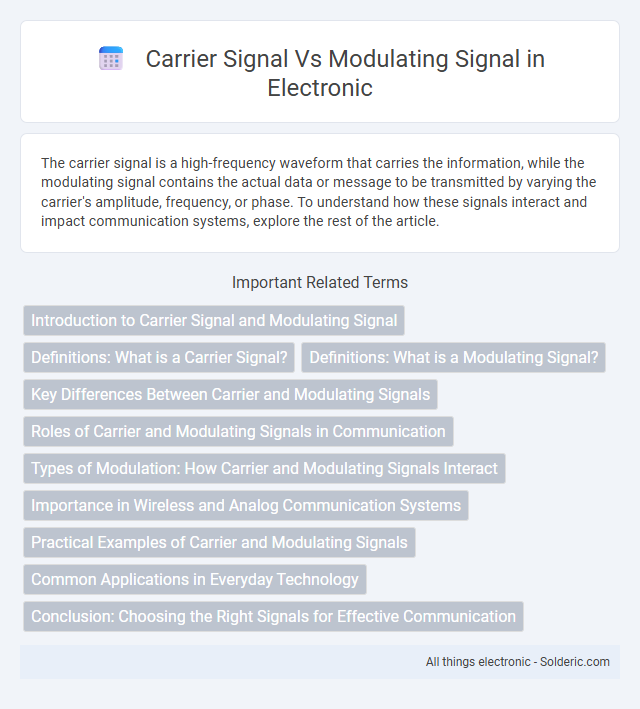The carrier signal is a high-frequency waveform that carries the information, while the modulating signal contains the actual data or message to be transmitted by varying the carrier's amplitude, frequency, or phase. To understand how these signals interact and impact communication systems, explore the rest of the article.
Comparison Table
| Feature | Carrier Signal | Modulating Signal |
|---|---|---|
| Definition | High-frequency waveform used to carry information | Low-frequency signal containing the original information |
| Frequency | Typically higher frequencies (e.g., MHz to GHz) | Lower frequencies (e.g., audio or baseband signals) |
| Purpose | Transmits the modulated data over a channel | Provides data or message to be transmitted |
| Signal Type | Usually sinusoidal waveform | Can be analog or digital signal |
| Role in Modulation | Carrier wave is varied in amplitude, frequency, or phase | Controls the variation parameters of carrier signal |
| Example Frequencies | Radio frequency (e.g., 1 MHz, 100 MHz) | Audio frequency (e.g., 1 kHz, 10 kHz) |
Introduction to Carrier Signal and Modulating Signal
Carrier signals are high-frequency waveforms used to transmit information over long distances by serving as a base for data encoding. Modulating signals carry the actual information, such as audio, video, or digital data, and alter the carrier signal's amplitude, frequency, or phase to transmit this information effectively. Understanding the relationship between the carrier signal and modulating signal is essential for optimizing communication system performance and ensuring your data is accurately conveyed.
Definitions: What is a Carrier Signal?
A carrier signal is a high-frequency waveform that serves as the base signal for transmitting information in communication systems. It remains constant in amplitude, frequency, or phase until it is varied by the modulating signal to encode data. Your communication system relies on the carrier signal to efficiently convey the modulating signal's information over long distances.
Definitions: What is a Modulating Signal?
A modulating signal is the information-carrying waveform that modifies the properties of a carrier signal, such as its amplitude, frequency, or phase, to enable effective transmission. The carrier signal, typically a high-frequency sinusoidal wave, remains constant and serves as the medium for conveying the modulating signal over communication channels. Understanding the interaction between the modulating signal and carrier signal is essential for optimizing communication system performance and ensuring reliable data transfer.
Key Differences Between Carrier and Modulating Signals
The carrier signal is a high-frequency waveform that acts as the base for transmitting information, while the modulating signal contains the actual data or message to be conveyed, typically with lower frequency. Carrier signals maintain a constant amplitude, frequency, or phase, whereas modulating signals vary these attributes to encode the information. Key differences include their frequency range, with carrier signals operating at significantly higher frequencies, and their function in communication systems--the carrier facilitates transmission, and the modulating signal imparts meaning to the carrier wave.
Roles of Carrier and Modulating Signals in Communication
Carrier signals serve as high-frequency waves that enable the transmission of information over long distances by providing a stable frequency for modulation. Modulating signals carry the actual information, such as voice or data, which alters the carrier wave's amplitude, frequency, or phase to embed the message. Your communication system relies on the interaction between these signals to effectively transmit and receive information with clarity and accuracy.
Types of Modulation: How Carrier and Modulating Signals Interact
Carrier signals serve as the high-frequency base wave that is modulated to carry information, while modulating signals contain the actual data or intelligence to be transmitted. Types of modulation such as Amplitude Modulation (AM), Frequency Modulation (FM), and Phase Modulation (PM) define the interaction by varying the carrier's amplitude, frequency, or phase respectively according to the modulating signal. The efficient interplay between the carrier and modulating signal determines the signal's bandwidth, power efficiency, and resilience to noise in communication systems.
Importance in Wireless and Analog Communication Systems
Carrier signals serve as high-frequency waves that enable the transmission of information over long distances in wireless and analog communication systems, while modulating signals contain the actual information such as voice or data that alters the carrier wave's amplitude, frequency, or phase. The importance of carrier signals lies in their ability to efficiently carry modulating signals through the communication channel, overcoming noise and interference. Understanding how your modulating signal impresses onto the carrier wave is crucial for optimizing signal clarity and transmission reliability in various communication technologies.
Practical Examples of Carrier and Modulating Signals
Carrier signals are high-frequency waveforms used in radio transmission, such as the 100 MHz carrier wave in FM radio broadcasting. Modulating signals, like audio voice or music signals in the range of 20 Hz to 20 kHz, alter the carrier's amplitude, frequency, or phase to encode information. Your radio receiver decodes these modulated carrier signals back into audible sound, illustrating the practical interaction of carrier and modulating signals in communication systems.
Common Applications in Everyday Technology
Carrier signals are essential in wireless communication, serving as the baseline frequency for transmitting data in technologies like radio broadcasting, mobile phones, and Wi-Fi networks. Modulating signals carry the actual information, such as voice, video, or digital data, by altering the carrier signal's amplitude, frequency, or phase in applications like TV transmission and satellite communication. Your smartphone relies on the interaction between carrier and modulating signals to ensure clear calls and fast internet connectivity.
Conclusion: Choosing the Right Signals for Effective Communication
Selecting the appropriate carrier signal and modulating signal is crucial for optimizing communication system performance, as the carrier signal provides a constant frequency that facilitates signal transmission over long distances, while the modulating signal carries the actual information. Your communication system's reliability and clarity depend on matching modulation techniques with the signal characteristics and channel conditions to minimize distortion and interference. Effective communication requires understanding the spectral efficiency, bandwidth requirements, and noise resilience associated with different carrier and modulating signal combinations.
carrier signal vs modulating signal Infographic

 solderic.com
solderic.com